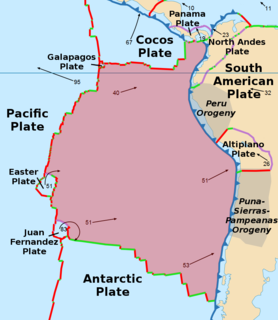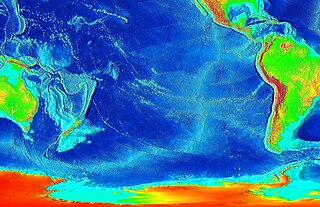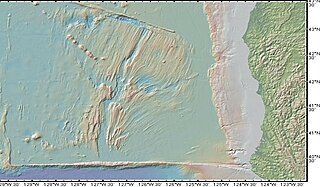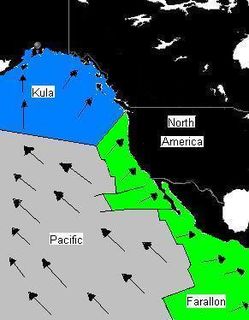
The North American Plate is a tectonic plate covering most of North America, Cuba, the Bahamas, extreme northeastern Asia, and parts of Iceland and the Azores. With an area of 76 million km2 (29 million sq mi), it is the Earth's second largest tectonic plate, behind the Pacific Plate.

The Nazca Plate or Nasca Plate, named after the Nazca region of southern Peru, is an oceanic tectonic plate in the eastern Pacific Ocean basin off the west coast of South America. The ongoing subduction, along the Peru–Chile Trench, of the Nazca Plate under the South American Plate is largely responsible for the Andean orogeny. The Nazca Plate is bounded on the west by the Pacific Plate and to the south by the Antarctic Plate through the East Pacific Rise and the Chile Rise respectively. The movement of the Nazca Plate over several hotspots has created some volcanic islands as well as east-west running seamount chains that subduct under South America. Nazca is a relatively young plate both in terms of the age of its rocks and its existence as an independent plate having been formed from the break-up of the Farallon Plate about 23 million years ago. The oldest rocks of the plate are about 50 million years old.

The Cocos Plate is a young oceanic tectonic plate beneath the Pacific Ocean off the west coast of Central America, named for Cocos Island, which rides upon it. The Cocos Plate was created approximately 23 million years ago when the Farallon Plate broke into two pieces, which also created the Nazca Plate. The Cocos Plate also broke into two pieces, creating the small Rivera Plate. The Cocos Plate is bounded by several different plates. To the northeast it is bounded by the North American Plate and the Caribbean Plate. To the west it is bounded by the Pacific Plate and to the south by the Nazca Plate.

The East Pacific Rise is a mid-ocean ridge, a divergent tectonic plate boundary located along the floor of the Pacific Ocean. It separates the Pacific Plate to the west from the North American Plate, the Rivera Plate, the Cocos Plate, the Nazca Plate, and the Antarctic Plate. It runs south from the Gulf of California in the Salton Sea basin in Southern California to a point near 55° S, 130° W, where it joins the Pacific-Antarctic Ridge trending west-southwest towards Antarctica, near New Zealand. Much of the rise lies about 3200 km (2000 mi) off the South American coast and rises about 1,800–2,700 m (6,000–9,000 ft) above the surrounding seafloor.

A triple junction is the point where the boundaries of three tectonic plates meet. At the triple junction each of the three boundaries will be one of three types – a ridge (R), trench (T) or transform fault (F) – and triple junctions can be described according to the types of plate margin that meet at them. Of the ten possible types of triple junction only a few are stable through time. The meeting of four or more plates is also theoretically possible but junctions will only exist instantaneously.

The Gorda Ridge, aka Gorda Ridges tectonic spreading center, is located roughly 200 kilometres (120 mi) off the northern coast of California and southern Oregon. Running NE – SW it is roughly 300 kilometres (190 mi) in length. The ridge is broken into three segments; the northern ridge, central ridge, and the southern ridge, which contains the Escanaba Trough.

The Galapagos Microplate (GMP) is a geological feature of the oceanic crust located at 1°50' N, offshore of the west coast of Colombia. The GMP is collocated with the Galapagos Triple Junction, which is an atypical ridge-ridge-ridge triple junction. At the Galapagos Triple Junction, the Pacific Plate, Cocos Plate, and Nazca Plate meet incompletely, forming two counter-rotating microplates at the junction of the Cocos-Nazca, Pacific-Cocos, and Pacific-Nazca spreading ridges.

The Azores Triple Junction (ATJ) is a geologic triple junction where the boundaries of three tectonic plates intersect: the North American Plate, the Eurasian Plate and the African Plate. This triple junction is located along the Mid-Atlantic Ridge (MAR) amidst the Azores islands, nearly due west of the Strait of Gibraltar. It is classed as an R-R-R triple junction of the T type, as it is an intersection of the Mid-Atlantic Ridge running north–south and the Terceira Rift which runs east-southeast.

The Aden Ridge is a part of an active oblique rift system located in the Gulf of Aden, between Somalia and the Arabian Peninsula to the north. The rift system marks the divergent boundary between the Somali and Arabian tectonic plates, extending from the Owen Transform Fault in the Arabian Sea to the Afar Triple Junction or Afar Plume beneath the Gulf of Tadjoura in Djibouti.

The Galapagos Triple Junction is a geological area in the eastern Pacific Ocean several hundred miles west of the Galapagos Islands where three tectonic plates - the Cocos Plate, the Nazca Plate and the Pacific Plate - meet. It is an unusual type of triple junction in which the three plates do not meet at a simple intersection. Instead, the junction includes two small microplates, the Galapagos Microplate and the Northern Galapagos Microplate, caught in the junction, turning synchronously with respect to each other and separated by the Hess Deep rift.

The Pacific-Farallon Ridge was a spreading ridge during the Late Cretaceous that extended 10,000 km in length and separated the Pacific Plate to the west and the Farallon Plate to the east. It ran south from the Pacific-Farallon-Kula triple junction at 51°N to the Pacific-Farallon-Antarctic triple junction at 43°S. As the Farallon Plate subducted obliquely under the North American Plate, the Pacific-Farallon Ridge approached and eventually made contact with the North American Plate about 30 million years ago. On average, this ridge had an equatorial spreading rate of 13.5 cm per year until its eventual collision with the North American Plate. In present day, the Pacific-Farallon Ridge no longer formally exists since the Farallon Plate has been broken up or subducted beneath the North American Plate, and the ridge has segmented, having been mostly subducted as well. The most notable remnant of the Pacific-Farallon Ridge is the 4000 km Pacific-Nazca segment of the East Pacific Rise.

The Juan Fernandez Plate is a microplate in the Pacific Ocean. With a surface area of approximately 105 km2, the microplate is located between 32° and 35°S and 109° and 112°W. The plate is located at a triple junction between the Pacific Plate, Antarctic Plate, and Nazca Plate. Approximately 2000 km to the west of South America, it is, on average, 3000 meters deep with its shallowest point coming to approximately 1600 meters, and its deepest point reaching 4400 meters.

The Mariana Plate is a micro tectonic plate located west of the Mariana Trench which forms the basement of the Mariana Islands which form part of the Izu–Bonin–Mariana Arc. It is separated from the Philippine Sea Plate to the west by a divergent boundary with numerous transform fault offsets. The boundary between the Mariana and the Pacific Plate to the east is a subduction zone with the Pacific Plate subducting beneath the Mariana. This eastern subduction is divided into the Mariana Trench, which forms the southeastern boundary, and the Izu–Ogasawara Trench the northeastern boundary. The subduction plate motion is responsible for the shape of the Mariana plate and back arc.

The Panama Plate is a microplate; a small tectonic plate that exists between two actively spreading ridges and moves relatively independently of its surrounding plates. The Panama plate is located between the Cocos Plate and Nazca Plate to the south and the Caribbean Plate to the north. Most of its borders are convergent boundaries including a subduction zone to the west. It consists, for the most part, of the nations of Panama and Costa Rica.
This is a list of articles related to plate tectonics and tectonic plates.

The Pacific Ocean evolved in the Mesozoic from the Panthalassic Ocean, which had formed when Rodinia rifted apart around 750 Ma. The first ocean floor which is part of the current Pacific Plate began 160 Ma to the west of the central Pacific and subsequently developed into the largest oceanic plate on Earth.

The Lwandle Plate is one of three tectonic microplates, along with the Rovuma Plate and Victoria Plate, that make up the African Plate with the Somali Plate and the Nubian Plate. Its discovery is very recent, so the velocity of the plate is neither well known nor well understood. Many experiments are ongoing to quantify this. The Lwandle Plate lies between 30°E and 50°E, sharing a boundary with the Nubian, Somali, and Antarctic Plates.

The Chile Ridge, also known as the Chile Rise, is a submarine oceanic ridge formed by the divergent plate boundary between the Nazca Plate and the Antarctic Plate. It extends from the triple junction of the Nazca, Pacific, and Antarctic plates to the Southern coast of Chile. The Chile Ridge is easy to recognize on the map, as the ridge is divided into several segmented fracture zones which are perpendicular to the ridge segments, showing an orthogonal shape toward the spreading direction. The total length of the ridge segments is about 550–600 km.





















